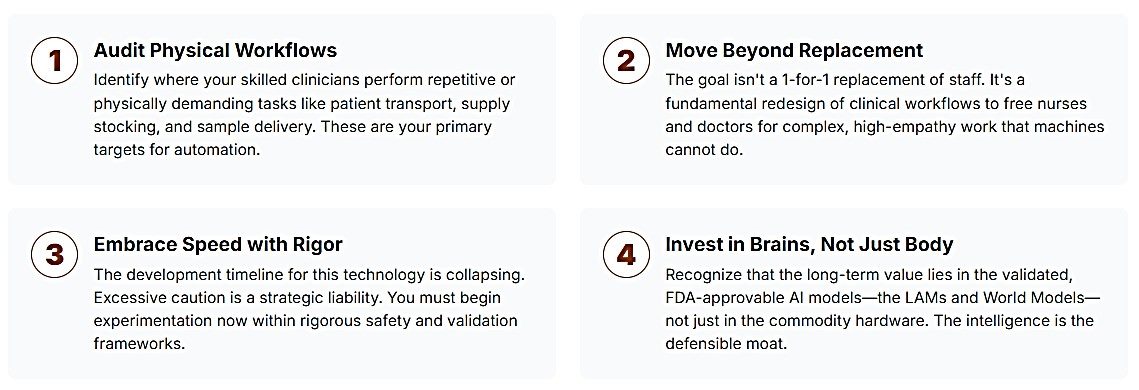Key Takeaways
- While you we are optimizing digital records, AI learned to walk. The physical world of your hospital is now the new frontier.
- The "Model T of robots" is here, with humanoids already being piloted in factories. Healthcare is next. What most leaders thought was a decade away is happening now.
- The long-term competitive advantage lies in the Large Action Models and "World Models" that give the hardware its safe, clinical-grade intelligence.
- Don't just see robots as a replacement for nurses' aides. Use them as a catalyst to radically redesign clinical workflows and free your best clinicians for top-of-license work.
- The first health system to master human-robot collaboration in care delivery will gain a massive, perhaps insurmountable, advantage in efficiency and quality.
For the past decade, our healthcare AI strategy has been focused on the digital realm — taming the EHR, optimizing billing codes, analyzing data. We’ve been focused on a revolution in knowledge work. This is a form of strategic blindness.
In the second week of October, a startup named Figure showed its new humanoid robot, Figure 03, a machine with astonishing dexterity that is already being piloted at a BMW plant. This isn't a demo; it's a deployment. The future of AI has a body, and it's coming for our hospital floors, our sterile labs, our pharmacies and our operating rooms. While we've been optimizing digital workflows, the physical world of patient care has become the new competitive battlefield.
This week, Figure has passed 5 months running on the BMW X3 body shop production line
— Brett Adcock (@adcock_brett) October 6, 2025
We have been running 10 hours per day, every single day of production!
It is believed that Figure and BMW are the first in the world to do this with humanoid robots pic.twitter.com/zAXCbApXBJ
I've spent my career challenging leaders to see beyond the horizon, to anticipate the revolutions that will remake our industries. Today, I am telling you that the revolution we've been watching on our screens is about to break out of its digital cage and walk onto the hospital. The abstract world of large language models is merging with the concrete reality of robotics, creating "embodied AI." This is not a distant, sci-fi fantasy. It is happening now, and for healthcare, it will be more transformative than the chatbot.
The recent unveiling of the Figure 03 humanoid robot is a watershed moment. This isn't just another impressive demo; it's being positioned as the "Model T of robots" designed for mass production and broad deployment. With plans to ship 100,000 units, the timeline for this transformation is compressing at a startling speed. What I thought would happen 5 to 10 years from now is happening today.
The Holy Grail of Dexterity: Where AI Finally Touches the Patient
For decades, the promise of robotics in care delivery has been hobbled by a single challenge: dexterity. We could build robots that were strong, but we couldn't build one with the nuanced grace to handle a fragile vial of medicine or assist a frail patient. The "holy grail" has been to train a robot to grip with precision and sensitivity.
This is not a hardware problem; it's an AI problem. And it's finally being solved.
Figure 03's impressive dexterity — folding linens, handling delicate objects — is driven by Helix, its proprietary vision-language-action AI model. They recognized that embodied AI needs its own custom-built brain. This, combined with custom in-house tactile sensors, is cracking the code. This is the critical link. The moment AI can reliably interact with the unpredictable, fragile and varied objects of the real world is the moment it moves from a specialized surgical tool to a general-purpose clinical and operational partner.
Related Article: 3 Stages of AI and What They Mean for Healthcare
The New Arms Race in Health-Bots: Beyond the Hype
While Figure 03 is the catalyst, it's part of a much larger, global arms race in physical AI that healthcare leaders must understand with clear eyes, distinguishing real progress from "smoke and mirrors."
- The Hype vs. Reality: Tesla's Optimus robot might generate headlines, but its staged demos and reported design problems with its hands are a stark reminder of the immense difficulty here. In healthcare, there is no room for error.
- The Industrial Juggernaut: SoftBank's recent $5.4 billion acquisition of ABB's industrial robotics division is a colossal bet on physical AI. ABB's robotic arms are already used in high-precision pharmaceutical manufacturing and lab automation. SoftBank's vision is to fuse this industrial might with "artificial super intelligence." This is about scaling the core production functions of health and life sciences.
- The Quiet Dominator: While we talk about humanoids, Amazon has already deployed 750,000 robots in its logistics network. This is a direct parallel to the massive, inefficient internal logistics of every hospital system: moving supplies, medications and equipment. Amazon has proven the immense economic value of physical AI in this domain.
- The Surgical Precedent: We have already seen the power of embodied AI with Intuitive Surgical's Da Vinci system. It proved that a robotic platform can enhance a surgeon's precision. Now, imagine that level of precision augmented with next-generation AI and applied to dozens of other tasks around the hospital.




The space is exploding. Two years ago, investors dismissed humanoids. Today, there are over 100 companies in the space. This is the "new space race," and the first health system to master human-robot collaboration will gain a massive advantage in efficiency, safety and quality of care.
The Brains Behind the Brawn: The Clinical AI Revolution
As a leader, it's easy to be mesmerized by the physical robot. But the real revolution, the scalable, defensible moat, is in the AI that drives it. This is where your strategic focus must be.


- Large Action Models (LAMs): Companies like Nvidia are pouring resources into these models. Unlike LLMs that output text, LAMs take in sensor data (vision, touch) and output physical actions relevant to a clinical or lab setting.
- World Models: This is perhaps the most critical concept for healthcare. World models are virtual training environments, hyper-realistic physics simulations of an operating room or a patient interaction. Here, an AI can run millions of simulated surgical assists or patient transfers per minute to learn a task safely, instead of a single, slow and risky trial on a real person. This is the key to safe, generalized physical intelligence in medicine.
As I've argued in "AI's Voracious Appetite for Land, Water and Power," the computational cost of training these massive models is immense, but is it the necessary investment to achieve this next leap in capability?
The Leadership Mandate: Prepare for the Physical Transformation of Care
For too long, your strategic conversations about AI have been confined to digital health. This is no longer sufficient. You must now apply the same revolutionary zeal to the physical world of care delivery.

- Audit Your Physical Workflows: Where in your organization — whether it's a hospital ward, a sterile lab, a pharmacy or a long-term care facility — are your skilled clinicians still performing repetitive, physically demanding or logistical tasks? Patient transport, supply stocking, sample delivery, medication dispensing. These are the front lines for the embodied AI revolution.
- Move Beyond the "Replacement" Mindset: The knee-jerk reaction will be to see these robots as one-for-one replacements for nurses' aides or lab techs. This is a failure of imagination, a classic example of what I call "The Efficiency Trap." The real opportunity is to redesign entire clinical workflows, freeing your nurses and doctors from physical drudgery to focus on complex diagnosis, patient communication and the high-empathy work that machines cannot do.
- Embrace the Speed with Clinical Rigor: The rapid improvement of Figure 03 proves that the timeline for this change is collapsing. As I've written in "AI's Autobahn: Why Speed Beats Caution," excessive caution is a strategic liability. We must begin experimenting now, within the rigorous safety and validation frameworks that healthcare demands.
- Invest in the Brains, Not Just the Body: When you partner or invest, recognize that the long-term value lies in the validated, FDA-approvable AI models, the LAMs and World Models, not just the hardware. The robot is the vessel; the AI is the intelligence that will transform care.
Related Article: The Human Advantage: How Healthcare Professionals Stay Relevant in the Age of GenAI
Final Thought
The AI revolution is breaking free from the confines of the EHR. It is learning to see, to touch and to interact with the physical world of patient care.
This shift from a purely digital intelligence to an embodied one will be more profound than anything I have seen yet. It will reshape hospital logistics, lab operations, surgical assistance and elder care. Leaders who continue to view AI as merely a software phenomenon are preparing for a future that is already obsolete.
The real question is no longer what AI can do for your data, but what it is about to do for your patients, your clinicians and your physical reality.
Frequently Asked Questions
Learn how you can join our contributor community.
